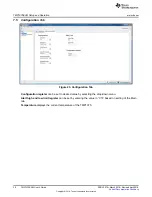
OUT
ADJ
REF
V
R
51.1 k
1
V
ª
º
§
·
: u «
»
¨
¸
«
»
©
¹
¬
¼
ADJ
OUT
REF
REF
R
V
V
V
51.1k
ª
º
§
·
u
«
»
¨
¸
:
©
¹
¬
¼
Board Connectors and Components
5
SNOU157A – March 2018 – Revised April 2018
Copyright © 2018, Texas Instruments Incorporated
TMP1075EVM User's Guide
3.2
EVM Power Supply Input – J1
TMP1075EVM uses the +5-V input power supply of the USB connector to power the EVM. The EVM does
not require an external power supply. The board is powered by the USB port and switches to +3.3 V. It
can be powered by shorting the J1 jumper with a regulated voltage with desired programmable voltage
such as 1.8 V, 3.3 V, and 3.6 V based on
. The EVM power supply input can be changed to
any input power supply range of the TMP1075 1.7 V to 5.5 V; however, note that the MSP430 can only
support a power supply range of 1.8 V to 3.6 V with the recommended V
OH
and V
OL
conditions listed in the
data sheet specifications.
The resistor adjust R
ADJ
can be calculated using
with the desired voltage of V
OUT
and where
V
REF
= 1.23 V, R
ADJ
= R6, and R8 = 51.1k
Ω
.
(1)
(2)
3.3
Interface Connector – J2
J2 is the USB connector, and used to connect the PC. The interface is used to access the device’s
registers and read the conversion data from the TMP1075 through I2C communication protocol.
3.4
Debug Jumper – J4
J4 is the connector that allows debugging the firmware using three wires instead of the standard 14-pin
header. This connector is not populated.
3.5
Pushbutton Switch – SW1
Basically, the SW1 is to bring the MSP430 into a BSL mode for upgrading the firmware with combination
of the USB connector manually referring to the picture in
BSL button (SW1 switch). Press and
hold the switch SW1 next to the USB connector while plugging the USB cable from the board to the PC.
This will allow bringing the MSP430 into BSL mode.
3.6
Header Connector – J3
The purpose of the header connector is to isolate the heat source and prevent it from heat incoming
directly into contact with the TMP1075, and the perforation allows users to snap at the breakout tab. When
the TMP1075 is separated from the MSP430, it can be connected through wires or header to both ends
for remote temperature measurements.
3.7
LED – (D4, D6, D7)
There are a total of three LEDs on the board: green (D4), red (D6), and orange (D7). The green LED is
the power supply indicator, and it should be turned ON. The orange LED should not blink when the EVM
is initially plugged into the PC. The orange LED will blink if the power-on-reset (POR) tests on the
MSP430 microcontroller fails on start-up or if the Test LED button is toggled. It will blink when the Start
Graph button is pressed. The red LED is the Alert pin indicator when the Alert pin is pulling LOW.




















